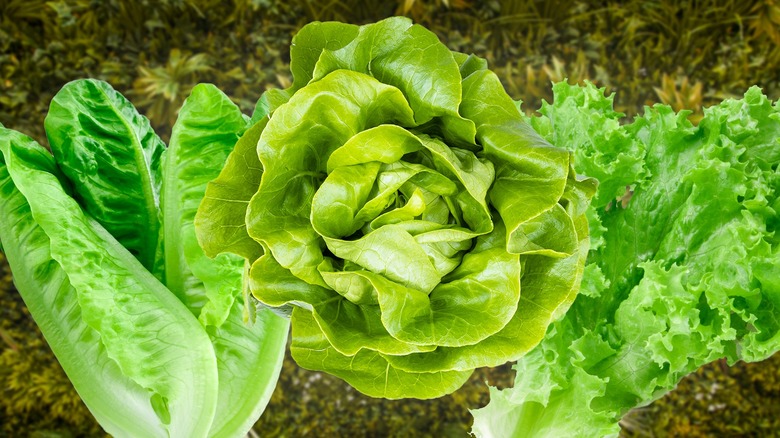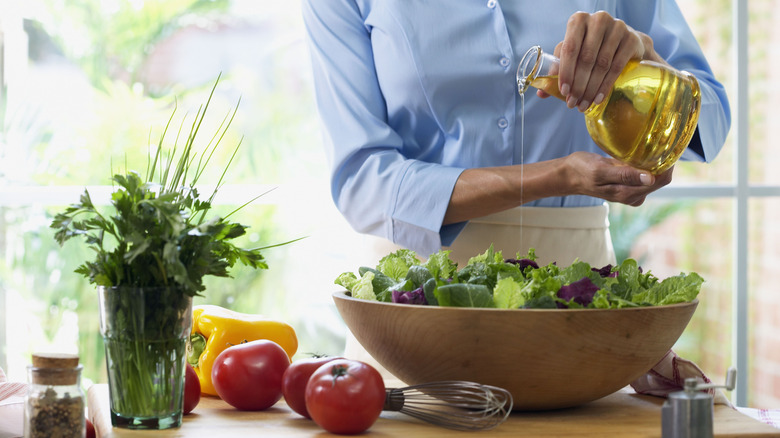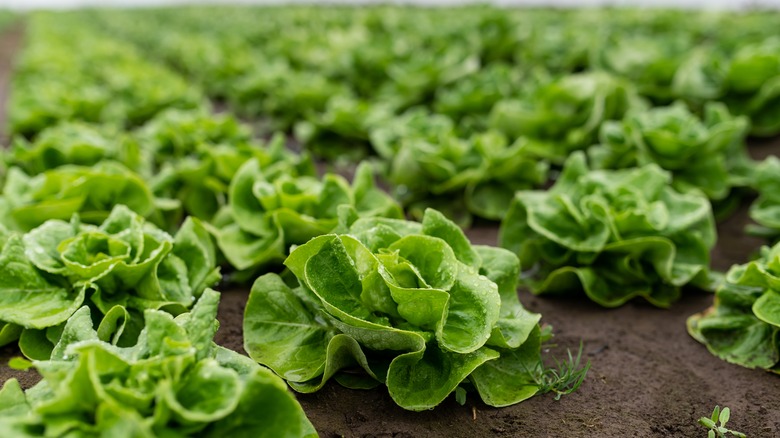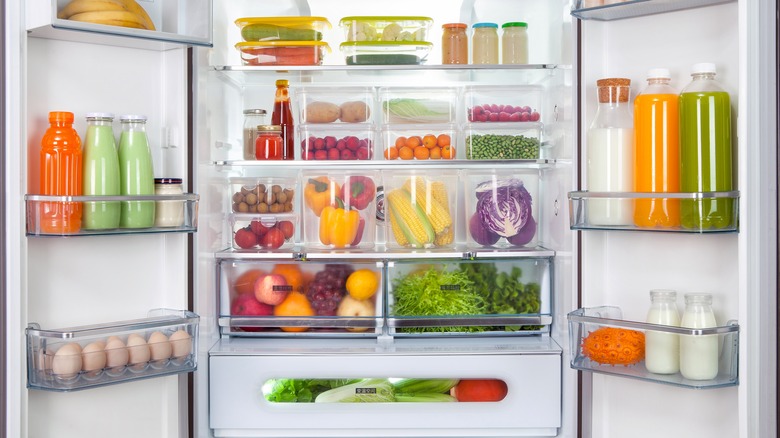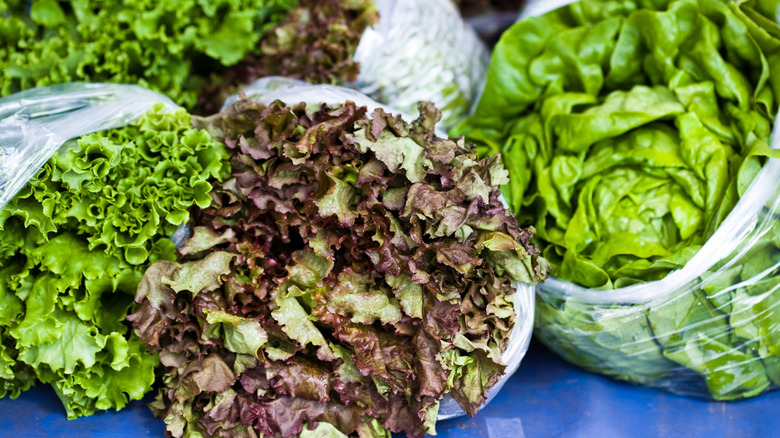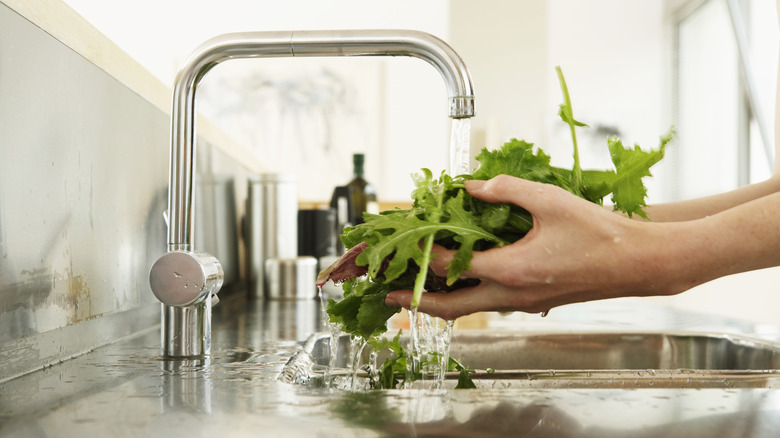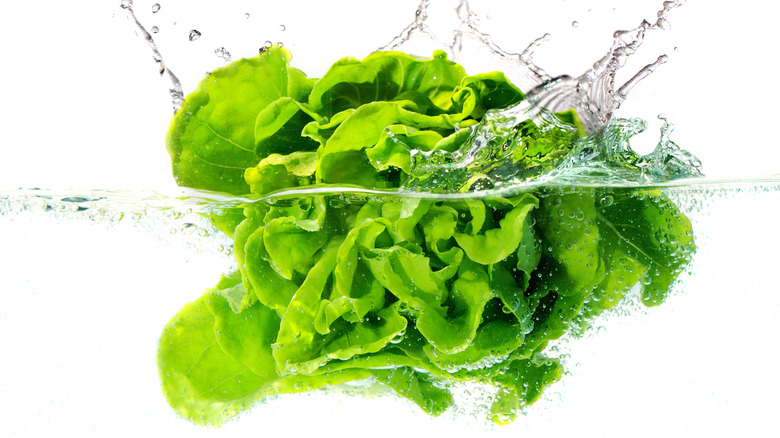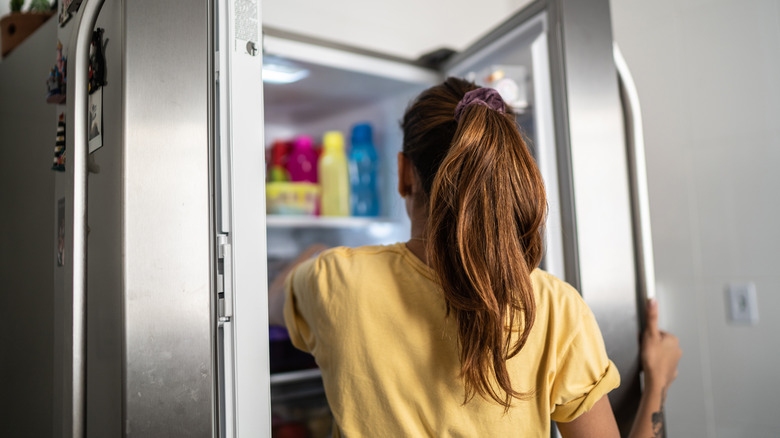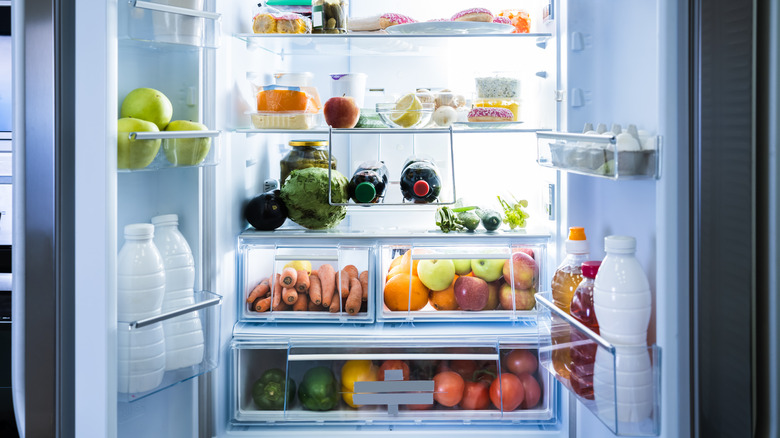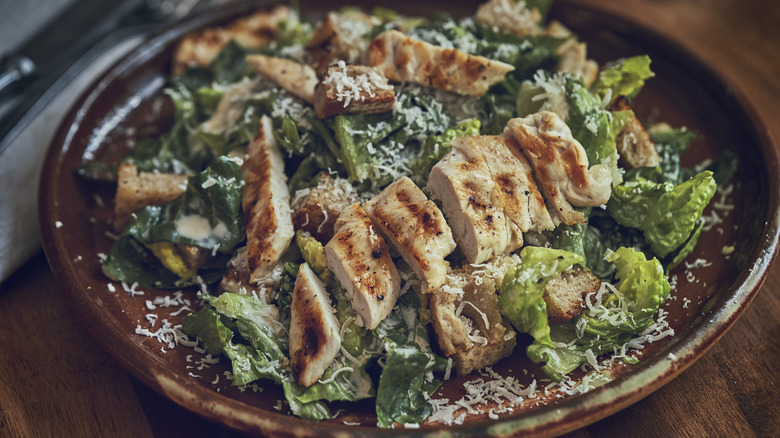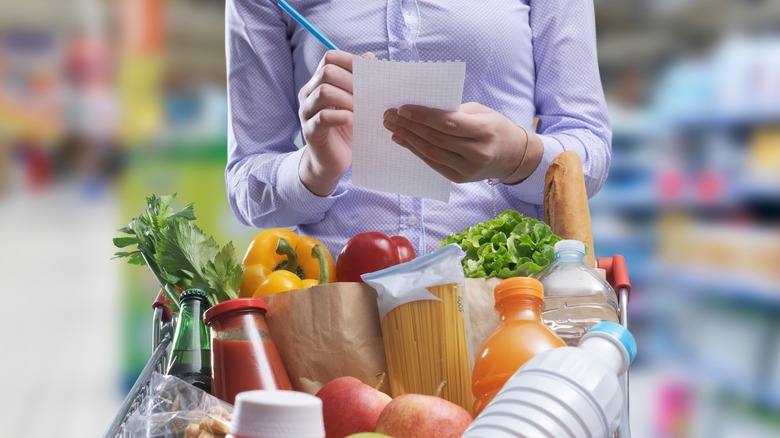Stop Wasting Lettuce: Tips For Getting The Most Out Of The Vegetable
As a base for delicious salads and a crisp a nutrient-rich addition to sandwiches, lettuce is a must-have item in a well-stocked fridge. But according to a recent survey from HelloFresh, lettuce is the top food that consumers have problems using up before it's past its prime. In fact, 27% of respondents reported they regularly let lettuce go to waste, and 73% expressed feeling bad when they have to throw out food.
Food waste is disheartening, is bad for the planet, and squanders your hard-earned money. Lettuce is especially sensitive to the effects of air and moisture, as well as gases from other produce that can speed up spoilage (via Business Insider Africa). Repeated bouts of tossing rotten greens might make you want to just stop buying lettuce and give up on salads forever.
But wait, don't toss out the salad before it's time! Instead, brush up on some ways you can change how you buy, store, and handle lettuce so that you can keep it fresh for longer. There are also creative ways to use it when it's no longer salad-worthy. Even if you do find a wilted bunch in the fridge, it doesn't necessarily have to go in the trash.
Start fresh
You can't keep lettuce fresh if it's not fresh to begin with. Knowing how to select produce at the grocery store can help you get the freshest lettuce that will last longer and get you more bang for your buck. If you shop at a good market, some of the work will be done for you through quality control. But that doesn't mean you should leave it entirely up to the produce department and pick up any head in the bunch.
Always inspect lettuce first. Make sure there is no visible browning or wilted leaves and minimal torn leaves (via Foodtown). Some tears will happen in the delivery process, but you don't want to choose any with multiple tears or tears that have started to turn brown.
You can also use touch to gauge the freshness of lettuce. In some places, handling produce might be frowned upon, but there's no official rule against it — and if you're paying for it, why shouldn't you be able to handle it first? Many people do. (That's why you should always wash fruits and veggies extra well!) Check as many of the top layers as you can to make sure they feel firm and don't exhibit any wilting or browning. Just be gentle with it.
Another tip: When you get to the checkout, don't damage your carefully selected lettuce by bagging it wrong. Make sure it's packed at the top of the bag so it doesn't get crushed by heavier items.
Buy living lettuce
Once lettuce is harvested, it's dead. Disconnected from its root ball, it's no longer receiving nutrients. With long travel times from the farmer to your market, exposure to light, moisture, and air, it continues to degrade. When it finally gets to your refrigerator, it doesn't have a long lifespan.
Living lettuce solves this problem. It's harvested and packaged with the root ball attached so it stays alive and attached to its nutrient source from the farmer to the grocery store shelves to your refrigerator. When you're ready to eat it, just separate what you need from the root ball and put the rest back in the fridge. Living lettuce can last as long as 18 days — possibly more (via Chicago Tribune).
You can typically find living lettuce in most big markets in major cities these days. Some packages will contain one type of lettuce, and others can contain two or more varieties. Common varieties include bibb, green and red leaf, Boston, oakleaf, and butterhead.
Store it correctly
First things first — lettuce should always be refrigerated. Cold temperatures help to preserve freshness and extend shelf life. Pop your lettuce in the fridge as soon as you get home. While it's easier to just throw stuff in the fridge willy-nilly without much thought, when it comes to lettuce — and all produce — it pays to pay attention to where you put it.
Store lettuce in a high-humidity crisper drawer (via Whirlpool). A high-moisture environment can help preserve the crispness and prevent wilting better than low-moisture environments. A high-humidity crisper drawer is closed off from the rest of the refrigerator, while a low-humidity crisper drawer is vented to allow air circulation throughout the fridge (via Martha Stewart). If your refrigerator has dual crisper drawers, you can set one to high-humidity and one to low-humidity. Store thin-skinned produce that is more likely to wilt, such as lettuce and leafy greens, broccoli, and cucumbers in high-humidity. The low-humidity drawer is better for fruits, such as apples, melons, pears, which are more likely to rot (via Whirlpool).
If your crisper drawers don't have any humidity controls or visible vents, they are high-humidity drawers. If you only have a single crisper drawer, it's also most likely high-humidity. You should still separate your produce and store high-humidity veggies in the drawer and put low-humidity fruits somewhere else in the refrigerator (via Martha Stewart).
Pack it properly
Before you store your lettuce, you need to make sure it's packed optimally to promote freshness and prolong its life. Not all lettuce should be packed the same way. And you shouldn't just assume that the way it's packaged when you pick it up at the market is the best way to keep it fresh in your fridge. Controlling moisture is key: Even though lettuce should be stored in the high-humidity crisper drawer, you don't want moisture directly on the leaves. This will lead to soggy leaves very quickly.
Hitchcock Farms recommends storing iceberg lettuce in a perforated bag, and romaine lettuce in a "loosely closed" plastic bag. As for loose-leaf lettuce in bags, you can let the leaves breath by snipping open the bag when you get it home from the market and before storage. For varieties that come packaged in plastic clamshell containers, open up the box and first sift through the greens to spot any leaves that may have started to get brown or mushy (via Food & Wine). Toss those. Then, take some paper towels or a dry dishcloth and line the interior of the container to absorb excess moisture before closing the lid again.
Wash it or don't wash it
Most experts say not to wash fruits and vegetables until you're ready to use them. This is because moisture can lead to the growth of bacteria and make produce spoil faster. Still, others say it's OK to wash some types of produce ahead of time, but not others.
While Colorado State University Extension recommends not washing any type of produce until you're ready to eat it, Hitchcock Farms recommends giving certain types a rinse. Specifically, they say that loose-leaf lettuce packaged in a box or a bag should be rinsed before being stored, even though many types have already been pre-washed. This is to prepare it for cold storage and get rid of any dirt or other debris. The Centers for Disease Control and Prevention (CDC), on the other hand, says lettuce and leafy greens labeled "ready to eat," "triple washed," or "no washing necessary" do not need to be rinsed or washed again before eating.
Hitchcock farms recommends not washing iceberg lettuce. It already has a high water content, and extra moisture from washing might promote wilting. Romaine and other types of lettuce can be left unwashed until you're ready to use them. However, whether or not to wash produce ahead of time or right before eating is a personal preference. Some people don't like to put unwashed produce in their fridge. If that's you, just make sure that you thoroughly dry lettuce in a salad spinner or on a dishcloth before you store it to keep extra moisture at bay.
Give it a bath
You might be able to perk up some droopy greens by soaking them in water for a while. Now, here's the catch: both ice water and hot water have been shown to work. Ice water bath is definitely the more widespread method. Cook's Illustrated tested this, taking heads of wilted lettuce, tearing up the leaves, and plunging them in an ice bath. They let the leaves soak for 30 minutes, and ended up with crisp lettuce.
Bon Appétit, on the other hand, says hot (120 degrees Fahrenheit) tap water works better. Let your greens sit in the water for 10 to 30 minutes before draining. Then, wrap them in a paper towel and pop them back in the fridge to chill. Or, if you need them ASAP, you can quickly drop them in an ice bath and dry them in a salad spinner before serving.
If you're confused about which method to use, try them both and see which one works best for you. A little kitchen experimentation can be fun. And if your lettuce is already past its prime, you haven't got much to lose.
Freeze it
Wait, you can freeze lettuce? Indeed. But don't get too excited. You can't store a head of romaine in the freezer and use to it make a Caesar salad next week; it's not going to be very good. Because of lettuce's high water content, freezing it will causes the plant's cell walls to expand and burst, changing the texture dramatically (via HGTV). In general, foods with lower water content, like corn, freeze better — a lot better — than lettuce.
Nevertheless, freezing it is better than tossing it in the bin. There are many ways to use thawed frozen lettuce that you probably haven't thought of. For example, you can make creamy, comforting lettuce soup, combining thawed lettuce with shallots, butter, dill, stock, and cream (via Great British Chefs). Almost any vegetable can be blended into a smoothie, no matter its texture. Toss any type of frozen lettuce into a blender with broccoli, cucumber, celery, pears, pineapple, green apple, coconut water, Greek yogurt, and ice cubes for a zero-waste green smoothie that's chock-full of nutrition (via Jessica Gavin).
Keep it front and center
In the HelloFresh survey on food waste, 35% of respondents said that food goes to waste simply because they forget about it. Leftovers that get shoved to the back, or that head of lettuce withering away deep in the crisper drawer, are likely to get skipped over because they're out of sight. A week later, they're a moldy, mushy mess that ends up in the garbage bin.
When storing your lettuce in the fridge, make sure you can see it. Since it's a more delicate item, you don't want it getting crushed under your heavier produce anyway, so keep it at the top of the crisper. If you know that your lettuce is on its last day, consider moving it front and center on the middle shelves so that you remember to use it for lunch or dinner. You can also set a reminder on your phone when you're likely to be doing meal prep.
Make baked and grilled lettuce salads
If you follow trends on TikTok, maybe you've heard of the baked salad. Actually, as chef and food stylist Carla Contreras told Yahoo! Life, warm salads go back millennia to Roman times. They usually include a mix of warmed greens, grains, seeds, and vegetables served with a cold or warm dressing. Leafy greens like spinach and kale are most commonly used, but you can use any type of lettuce, such as romaine or red leaf. If it's already wilting in the fridge, this is the perfect way to put it to good use rather than putting it in the trash.
Here's an idea for a one-pan roasted romaine salad that makes a full meal in 45 minutes with minimal prep: spread out cubed and seasoned chicken, grape tomatoes, garlic gloves, and romaine hearts on a baking sheet and roast them in the oven (via Rachel Cooks). Then, throw them in a bowl with your favorite dressing. You can also put a head of wilted romaine on the grill, chop it, and top it with a mayonnaise and mustard vinaigrette (via The New York Times). Add grilled chicken breast and croutons for a quick weeknight meal.
Choose lettuce alternatives
Salads don't have to have lettuce. If you find that you are continually ending up with soggy greens, you can use some alternative salad bases that last a lot longer than lettuce. Cabbage is a great replacement for greens, and it lasts a long time — up to two months in the fridge, according to TIME Magazine.
The most common type of cabbage is the tightly packed green head you see at the grocery store. You can choose red or Napa cabbage (the latter is delicious in stir-frys), which are also commonly found in most grocery stores. Keep in mind that some types of cabbage will last longer than others. In general, the looser the leaves, the shorter the shelf life. Napa cabbage's leaves are less tightly packed than green or red cabbage, but a head will still last about two weeks in the fridge in an air-tight container (via Red Wagon Farm). Cabbage is also packed with nutrition. As a member of the cruciferous vegetable family, along with broccoli and Brussels sprouts, it's a good source of vitamin C, folate, iron, calcium, and selenium, as well as fiber (via WebMD). Cruciferous vegetables are also high in cancer-fighting antioxidants.
Chop the leaves into bite-size pieces and mix them with your favorite veggies and proteins, then top with your favorite salad dressing. You might not even miss the lettuce.
Plan your meals before you shop
Many people go to the grocery store with little forethought about what they're actually there to buy. This leads to impulse buys and buying more than they need. In fact, according to the HelloFresh survey, Americans waste almost $3,000, on average, on groceries they buy but never use.
If you want to stop wasting lettuce — and other foods — it helps to plan your meals before you go to the store. That way, you know how much to buy, or whether you even need it at all. Meal planning can be time-consuming, but not only will it help save the lettuce from the trash (and your cash), it will also help you be more organized during the week, because you know what you're going to eat for each (or most) meals. You'll save time scrambling for something to cook for dinner, and potentially save extra trips to the store to get ingredients you need for last-minute meals.
You can use a calendar or a meal-planning app on your phone to make a rough sketch of what you want to make for lunches and dinners for a week, a few weeks, or even the whole month. Then, each time you're going to do your shopping, you can plan your meals in more detail, writing down all the ingredients and quantities you need to prepare those meals.
Compost what you can't use
A last resort for using up lettuce and preventing waste is composting. This involves turning kitchen scraps into a nutrient-rich soil-like substance that you can use in your garden, instead of sending it to a landfill. According to the Connecticut Department of Energy & Environmental Protection, composting can reduce the amount of trash your household creates by up to 25%. All you need is a little spot in your garden to pile up your kitchen scraps and tend to it every once in a while to make sure it's decomposing optimally.
Don't have a yard? No problem — you can even compost in an apartment using a small compost bin you can buy or make yourself (via Help Me Compost). Use the compost in your indoor potted plants, or in a balcony planter if you have one. You can also gift your compost to gardener friends or donate it to community gardens and farmers markets.
